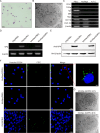GCRV-II invades monocytes/macrophages and induces macrophage polarization and apoptosis in tissues to facilitate viral replication and dissemination
- PMID: 38345385
- PMCID: PMC10949474
- DOI: 10.1128/jvi.01469-23
GCRV-II invades monocytes/macrophages and induces macrophage polarization and apoptosis in tissues to facilitate viral replication and dissemination
Abstract
Grass carp reovirus (GCRV), particularly the highly prevalent type II GCRV (GCRV-II), causes huge losses in the aquaculture industry. However, little is known about the mechanisms by which GCRV-II invades grass carp and further disseminates among tissues. In the present study, monocytes/macrophages (Mo/Mφs) were isolated from the peripheral blood of grass carp and infected with GCRV-II. The results of indirect immunofluorescent microscopy, transmission electron microscopy, real-time quantitative RT-PCR (qRT-PCR), western blot (WB), and flow cytometry analysis collectively demonstrated that GCRV-II invaded Mo/Mφs and replicated in them. Additionally, we observed that GCRV-II induced different types (M1 and M2) of polarization of Mo/Mφs in multiple tissues, especially in the brain, head kidney, and intestine. To assess the impact of different types of polarization on GCRV-II replication, we recombinantly expressed and purified the intact cytokines CiIFN-γ2, CiIL-4/13A, and CiIL-4/13B and successfully induced M1 and M2 type polarization of macrophages using these cytokines through in vitro experiments. qRT-PCR, WB, and flow cytometry analyses showed that M2 macrophages had higher susceptibility to GCRV-II infection than other types of Mo/Mφs. In addition, we found GCRV-II induced apoptosis of Mo/Mφs to facilitate virus replication and dissemination and also detected the presence of GCRV-II virus in plasma. Collectively, our findings indicated that GCRV-II could invade immune cells Mo/Mφs and induce apoptosis and polarization of Mo/Mφs for efficient infection and dissemination, emphasizing the crucial role of Mo/Mφs as a vector for GCRV-II infection.IMPORTANCEType II grass carp reovirus (GCRV) is a prevalent viral strain and causes huge losses in aquaculture. However, the related dissemination pathway and mechanism remain largely unclear. Here, our study focused on phagocytic immune cells, monocytes/macrophages (Mo/Mφs) in blood and tissues, and explored whether GCRV-II can invade Mo/Mφs and replicate and disseminate via Mo/Mφs with their differentiated type M1 and M2 macrophages. Our findings demonstrated that GCRV-II infected Mo/Mφs and replicated in them. Furthermore, GCRV-II infection induces an increased number of M1 and M2 macrophages in grass carp tissues and a higher viral load in M2 macrophages. Furthermore, GCRV-II induced Mo/Mφs apoptosis to release viruses, eventually infecting more cells. Our study identified Mo/Mφs as crucial components in the pathway of GCRV-II dissemination and provides a solid foundation for the development of treatment strategies for GCRV-II infection.
Keywords: GCRV-II; apoptosis; grass carp (Ctenopharyngodon idella); monocytes/macrophages; polarization; viral dissemination.
Conflict of interest statement
The authors declare no conflict of interest.
Figures







Similar articles
-
Type II Grass Carp Reovirus Rapidly Invades Grass Carp (Ctenopharyngodon idella) via Nostril-Olfactory System-Brain Axis, Gill, and Skin on Head.Viruses. 2023 Jul 23;15(7):1614. doi: 10.3390/v15071614. Viruses. 2023. PMID: 37515300 Free PMC article.
-
Type II Grass Carp Reovirus Infects Leukocytes but Not Erythrocytes and Thrombocytes in Grass Carp (Ctenopharyngodon idella).Viruses. 2021 May 10;13(5):870. doi: 10.3390/v13050870. Viruses. 2021. PMID: 34068469 Free PMC article.
-
Grass carp reovirus induces apoptosis and oxidative stress in grass carp (Ctenopharyngodon idellus) kidney cell line.Virus Res. 2014 Jun 24;185:77-81. doi: 10.1016/j.virusres.2014.03.021. Epub 2014 Mar 25. Virus Res. 2014. PMID: 24680657
-
Unraveling Macrophage Polarization: Functions, Mechanisms, and "Double-Edged Sword" Roles in Host Antiviral Immune Responses.Int J Mol Sci. 2024 Nov 10;25(22):12078. doi: 10.3390/ijms252212078. Int J Mol Sci. 2024. PMID: 39596148 Free PMC article. Review.
-
Monitoring Macrophage Polarization in Infectious Disease, Lesson From SARS-CoV-2 Infection.Rev Med Virol. 2025 May;35(3):e70034. doi: 10.1002/ird3.70006. Rev Med Virol. 2025. PMID: 40148134 Free PMC article. Review.
Cited by
-
Strain-specific differences in reovirus infection of murine macrophages segregate with polymorphisms in viral outer-capsid protein σ3.J Virol. 2024 Nov 19;98(11):e0114724. doi: 10.1128/jvi.01147-24. Epub 2024 Oct 21. J Virol. 2024. PMID: 39431846 Free PMC article.
-
GCRV-II Triggers B and T Lymphocyte Apoptosis via Mitochondrial ROS Pathway.Viruses. 2025 Jun 30;17(7):930. doi: 10.3390/v17070930. Viruses. 2025. PMID: 40733549 Free PMC article.
-
Comprehensive review of macrophage models: primary cells and immortalized lines across species.Front Immunol. 2025 Aug 20;16:1640935. doi: 10.3389/fimmu.2025.1640935. eCollection 2025. Front Immunol. 2025. PMID: 40909285 Free PMC article. Review.
References
-
- Pei C, Ke F, Chen Z-Y, Zhang Q-Y. 2014. Complete genome sequence and comparative analysis of grass carp reovirus strain 109 (GCReV-109) with other grass carp reovirus strains reveals no significant correlation with regional distribution. Arch Virol 159:2435–2440. doi:10.1007/s00705-014-2007-5 - DOI - PubMed
MeSH terms
Substances
Grants and funding
LinkOut - more resources
Full Text Sources
Research Materials

